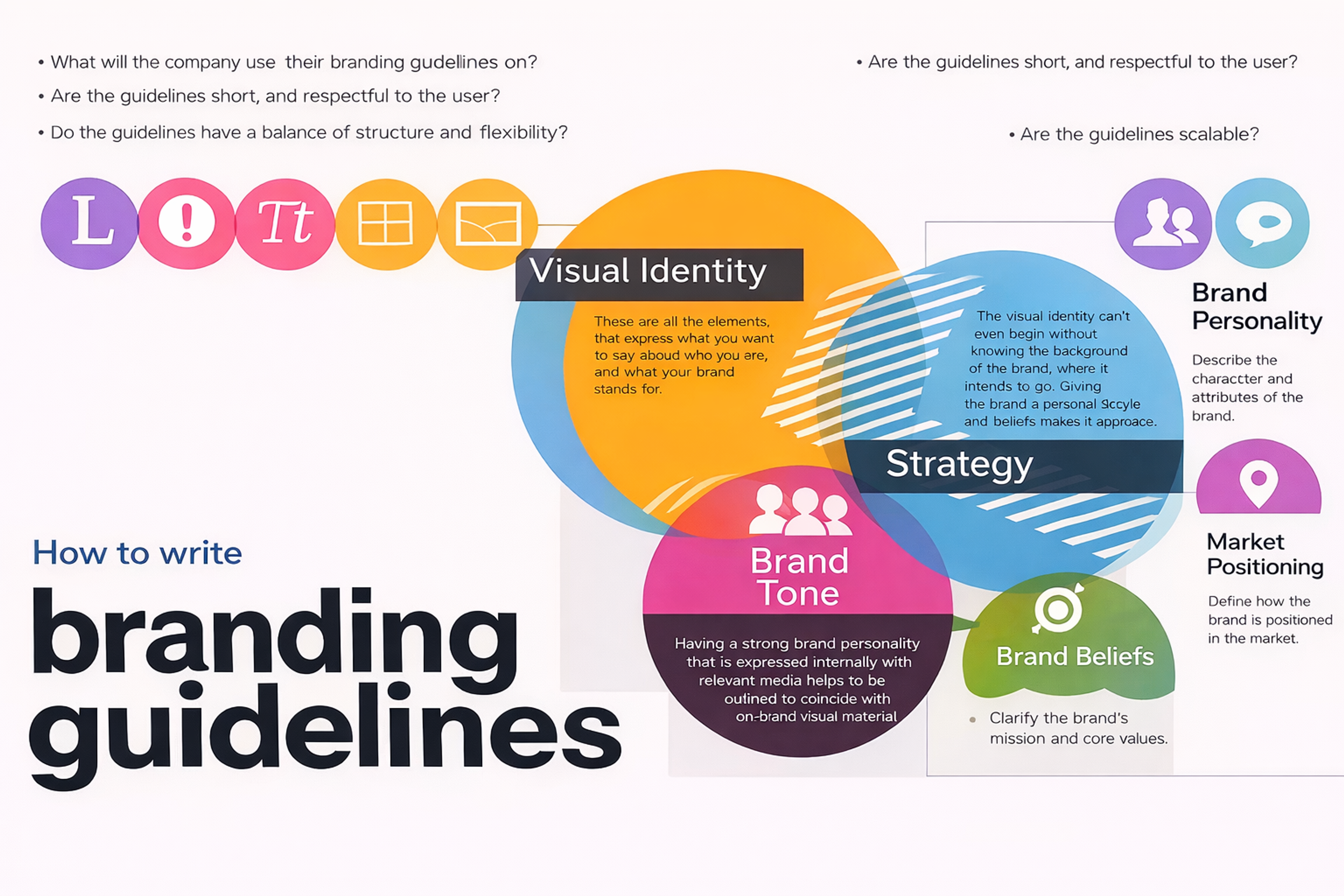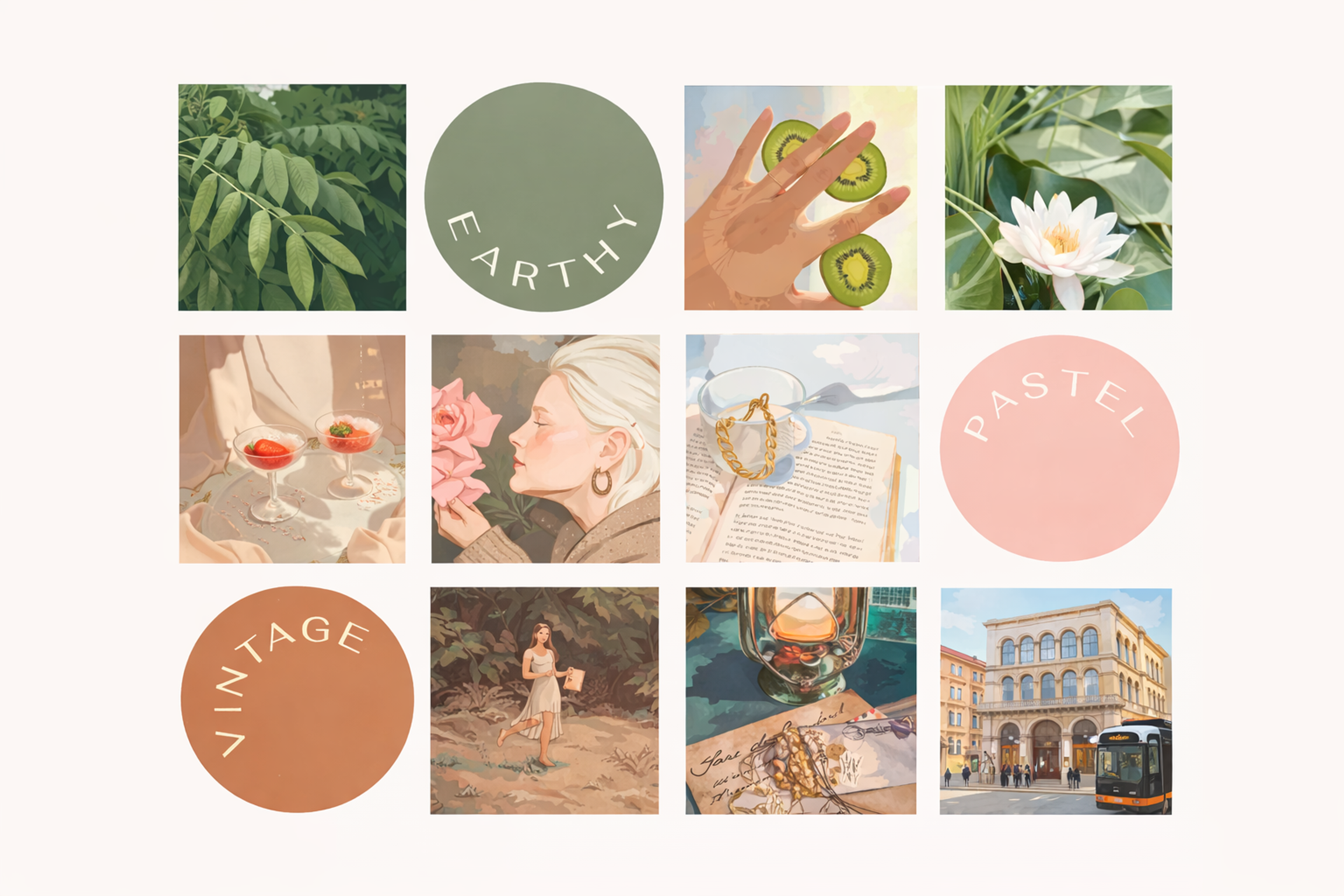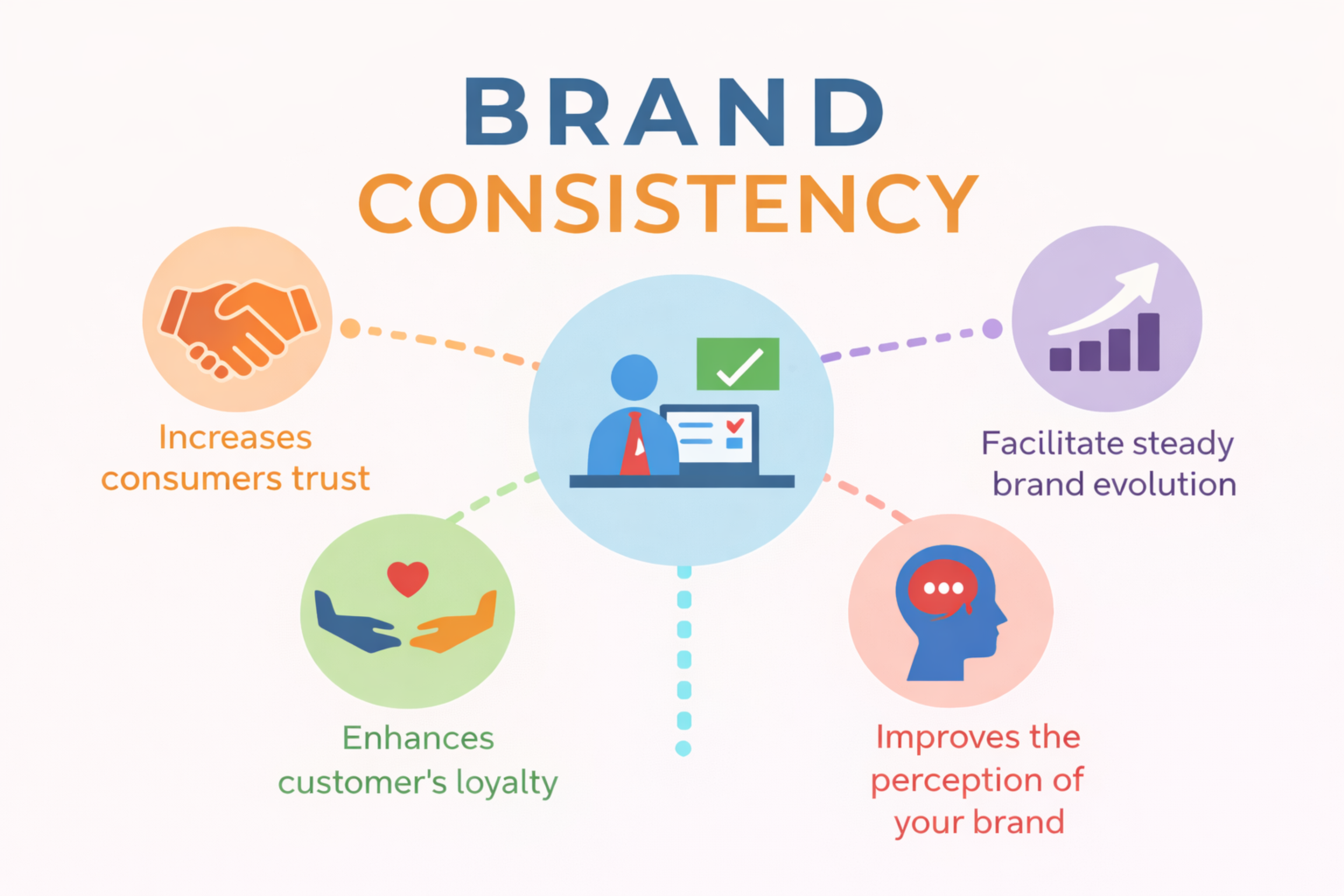The look and feel of your brand can be the difference between success and failure. A strong brand aesthetic helps you stand out from the competition and makes it easier for people to connect with your business.
It can show what your company values, build trust, and even create lasting loyalty. But how do you design an aesthetic that really speaks to your audience? For businesses like crypto or Web3, where trust matters most, the right design can also make hard topics easier to understand and help build a strong community.
To get started, focus on a few key steps that will guide you in creating a brand aesthetic that truly fits your audience.
Key Takeaways
Creating a strong brand aesthetic helps your business stand out, build trust, and connect emotionally with your audience. It’s more than just looks — it reflects digital aesthetics and your brand’s values and personality.
- Know your target audience and study competitors to shape a unique visual style.
- Use consistent elements like color, typography, and imagery across all platforms.
- Choose a design style (e.g. minimalist, bold, retro) that matches your message.
- Pick colors and fonts that are clear, meaningful, and culturally appropriate.
- Use storytelling to make your visuals more engaging and memorable.
A thoughtful brand aesthetic makes your brand easier to recognize and more likely to be remembered. It also enhances digital aesthetics by providing a clean, recognizable, and professional presence across platforms.
What Is a Brand Aesthetic?
Brand aesthetics is an important part of brand identity that helps customers identify with your brand, create an emotional connection, and build brand loyalty. A brand aesthetic represents various elements such as colors, typography, illustrations, images, icons, etc. It often reflects digital minimalist aesthetics when simplicity is aligned with clarity and ease of use.
Brand Guide Components

A strong brand aesthetic creates framework for all your visual communications. This framework guides every design decision you make and ensures your brand looks consistent across all platforms.
Analyzing Your Target Audience and Competitors
When building a strong and unique brand look, start by thinking about who you're trying to reach. Study what kinds of visuals they enjoy. Look at the colors, styles, and images that catch their attention. If you know what they like, you can design something that speaks directly to them.
You should also check out what your competitors are doing. This helps you see what’s common — and how you can do things differently. Using original visuals makes your brand stand out and feel more memorable.
Aesthetic Collage

To learn more about your audience, you can run surveys, talk to potential customers, or dig into tools like Google Analytics and social media. These sources can show you what your audience likes, how they behave, and how they prefer to see content.
Understanding both your audience and your competition gives you the power to shape a visual identity that grabs attention and feels fresh. This research creates an aesthetic framework that supports all your design choices.
Building Brand Identity
Building a brand identity is key to creating a style that connects with your audience. A strong identity uses visuals that feel real, consistent, and easy to remember. This helps your brand stand out and builds trust over time.
To create a style that feels unique, start with the basics — your brand’s mission, vision, goals, values, and brand personality. These ideas shape the way your brand looks and feels. Ask yourself why your brand exists and what it believes in. This will guide the colors, fonts, and images you use. Your message should always be clear and easy to understand.
Once you’ve defined your brand, stick with it. Consistency is what makes your brand familiar and trustworthy. People should recognize your look whether they see it on a website, a billboard, or social media. A consistent visual style shows you're reliable, which makes a big difference.
Components of Brand Consistency

Use the same set of colors across all your materials — like business cards, letterheads, and logos. This helps create a strong, unified look. Pick fonts that are easy to read, no matter the size. Your text should be clear, whether it's on a large poster or a small email signature.
Add icons or illustrations that match your brand’s message. These visuals should fit in well with the rest of your design and feel like part of the same family.
To keep your brand fresh and interesting, update your look from time to time. You might try new colors or change your fonts, but keep the same main branding elements, like your logo or key graphics. This way, your brand stays recognizable while still feeling modern and up-to-date. This approach establishes an aesthetic framework that can evolve with your brand over time.
Understanding Different Design Styles
Knowing different design styles helps you create brand visuals that connect with your audience. Design styles include visual elements like fonts, colors, images, and layout. You can mix and match styles depending on what your brand wants to say and how it wants to look.
Design styles vary widely — they can be minimalist or detailed, modern or vintage, playful or serious. The key is to match the style to your brand’s mission and values. For example, a brand focused on new ideas might use a modern look, while a brand built on trust might choose clean lines and bold fonts.
Brand Personality Examples by Clay

Some styles, like Baroque, use rich, detailed design to show craftsmanship and stir emotions. Classic symbols or icons can also add depth and meaning to your visuals.
Your audience matters, too. Pick a style that speaks to them. For example, if you’re trying to reach young adults, you might use bright colors and bold, fun fonts. The right design style makes your brand feel relatable and helps people immediately connect with it.
Choosing the Right Color Palette
Picking the right color palette is key to building your brand’s look. Your chosen colors should reflect your brand’s personality, values, and message. They also need to appeal to your audience.
But color meanings can change depending on culture, so always think about who you're designing for. What feels bold in one place might seem too loud in another.
It’s also important to understand how colors work together. Using shades that are too similar can make your design feel flat or dull. On the other hand, using too many different colors can feel messy and confusing.
A good rule is to stick with three or four primary colors, then add a few accent shades for extra detail and focus. This helps your visuals stay balanced, clear, and easy to remember.
Color Wheel by Clay

When designing brand visuals, it’s important to consider what colors mean in different cultures. A color that feels positive in one place might send the wrong message in another.
For example, red often stands for love and passion in Western countries. But in some Eastern cultures, red can mean danger or even death. Blue is another example — it may suggest trust and calmness in the West, but it can also be linked to sadness in other parts of the world.
Always research your audience's cultural background. This helps you choose colors that send the right message and avoid confusion.
Picking the Typography
Choosing the right fonts is a big part of building your brand’s look. The typography you use should reflect your brand’s values and style. It also needs to look good and stay consistent across all your visuals. This helps people recognize and remember your brand.
There are two main types of fonts: serif and sans-serif. Serif fonts have small lines at the ends of each letter. They feel classic and formal and are great for brands that want to show trust or tradition.
Sans-serif fonts don’t have those extra lines. They feel clean, simple, and modern — perfect for brands that want a fresh and professional vibe.
It’s a good idea to choose two main fonts for your brand. Use one for headlines and titles and the other for body text. You can also use bold or regular styles from the same font family to create variety without using too many different fonts. This keeps your design neat, clear, and easy to read.
Typography Examples by Clay

Engaging in Storytelling
Storytelling is a creative and powerful way to make your brand stand out. It helps people feel something — and that emotional connection makes your brand more memorable and meaningful.
When designing brand visuals, try to tell a story that reflects your values and shares your message. Think about your audience while doing this. The style of the story and visuals should match what they care about. For example, if you're speaking to young adults, you might use trendy designs and bold colors. If your audience is older, a more classic look might work better.
Brand Story Template by Clay

You can also use visuals to add emotion to your story. Light, floating images like balloons or birds can show joy and freedom. Dark colors or shadows might suggest mystery or fear. These small touches help bring your story to life and make it more engaging.
Telling strong, clear stories through design helps your brand connect with people. Combining message, emotion, and visual style (and always keeping your audience in mind) allows you to create a brand aesthetic that feels real, lasting, and easy to recognize.
Brand Aesthetic Examples
Minimalist
Minimalist brands prioritize function and clarity, often relying on negative space and pared-back elements to communicate their identity.
- Apple – Iconic for its minimal product design, monochrome visuals, and restrained branding.
- Aesop – Uses simple packaging and a monochromatic palette, focusing attention on product quality.
- Cereal Magazine – Applies a minimalist editorial style with serene visuals and ample whitespace.
- COS – Fashion brand known for clean lines, muted colors, and timeless silhouettes.
COS

Vintage/Retro
Retro branding evokes a sense of familiarity and emotional connection by tapping into aesthetics from earlier decades.
- Polaroid – Embraces its legacy with retro design elements and nostalgic color schemes.
- Coca-Cola (heritage campaigns) – Often uses vintage-inspired typography and visuals in retro campaigns.
- Barbasol – Maintains its classic Americana aesthetic from the 1920s.
- Dr. Martens – Leverages '80s and '90s grunge/punk visuals to strengthen its subcultural identity.
Dr. Martens

Bold and Vibrant
These brands don’t shy away from color, motion, and expressive graphics to grab attention and communicate energy.
- Benetton – Known for provocative and colorful campaigns with social commentary.
- Skittles – Uses rainbow colors, quirky visuals, and surreal humor.
- Oatly – Combines saturated colors with playful, handwritten typography and cheeky messaging.
Benetton Website

Luxury and Elegant
Luxury branding is all about detail, balance, and timeless beauty, often supported by artisanal craft and legacy.
- Tiffany & Co. – Instantly recognizable for its robin egg blue and refined serif typography.
- Hermès – Elegant equestrian-inspired visuals, minimal layouts, and high-end craftsmanship.
- Rolex – Embodies prestige with classic design and understated marketing.
- La Mer – Combines luxury with nature-based messaging in a soft, elegant aesthetic.
Tiffany&Co.

Nature-Inspired
These brands echo natural beauty and sustainability with tactile visuals and calming palettes.
- Patagonia – Rustic color schemes and outdoor imagery reinforce its eco-activist stance.
- Dr. Bronner’s – Earthy labels, natural ingredients, and socially conscious messaging.
- Lush – Handmade visuals, natural product presentation, and a green-focused mission.
- Tata Harper – Skincare brand that uses green packaging, floral motifs, and sustainability messaging.
Dr. Bronner's

Read more
FAQ
How to Choose a Brand Aesthetic?
Choose a brand aesthetic by first understanding your target audience, brand values, and overall message. Then, pick design elements — like colors, fonts, and imagery — that reflect those ideas and create a consistent, recognizable look across all platforms. This approach supports audience engagement by making your brand more visually appealing and relatable.
Why Are Aesthetics Important in Brand Identity?
Aesthetics are important in brand identity because they shape how people see and feel about your brand. A clear, consistent visual style builds recognition, trust, and emotional connection, which helps your brand stand out and stay memorable. Strong brand visuals also improve audience engagement by making it easier for people to connect with and remember your brand.
How Do You Make a Brand Aesthetic on Instagram?
To make a brand aesthetic on Instagram, use a consistent color palette, font style, and editing style for all your posts. Plan your feed layout, use high-quality visuals, and align your content with your brand’s voice and values to create a cohesive look. Regularly reviewing performance metrics helps you analyze audience engagement and adjust your visual strategy accordingly.
What Is a Business Aesthetic?
A business aesthetic is the visual style and mood a brand uses to express its identity. It includes design elements like colors, typography, logos, and imagery that work together to communicate the brand’s personality and values. A consistent aesthetic also helps track brand audience engagement over time, ensuring that your visual strategy continues to resonate with your followers.
Conclusion
Crafting brand visuals that capture customers' attention and represent brand values is key to establishing a successful design aesthetic. By understanding how different elements interact, such as font types and visual storytelling techniques, you can create brand aesthetics that are memorable and effective in communicating your brand messages.
With careful consideration for the target audience, you can develop brand visuals that truly resonate with them while setting yourself apart from competitors. Ultimately, by considering all these factors when creating brand visuals, you’ll be on your way to building an engaging and impactful design aesthetic for your business.


About Clay
Clay is a UI/UX design & branding agency in San Francisco. We team up with startups and leading brands to create transformative digital experience. Clients: Facebook, Slack, Google, Amazon, Credit Karma, Zenefits, etc.
Learn more

About Clay
Clay is a UI/UX design & branding agency in San Francisco. We team up with startups and leading brands to create transformative digital experience. Clients: Facebook, Slack, Google, Amazon, Credit Karma, Zenefits, etc.
Learn more


